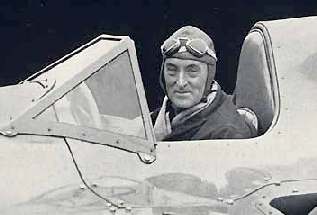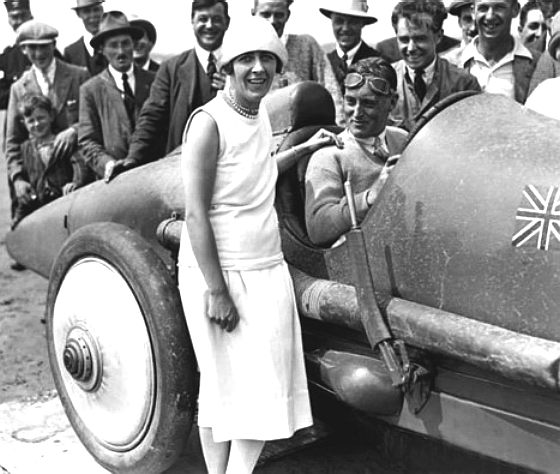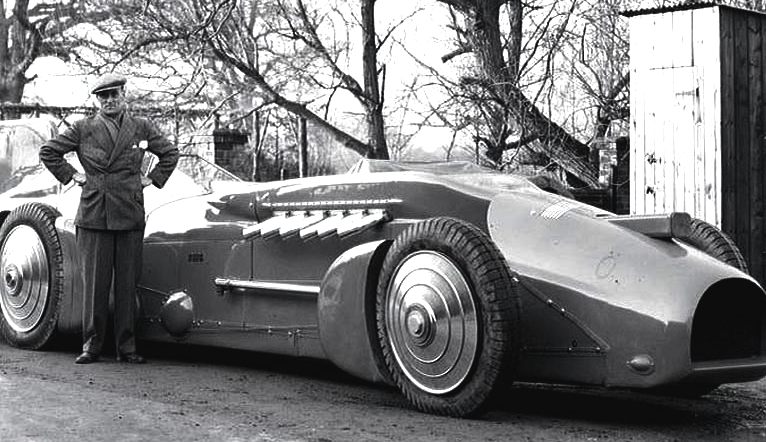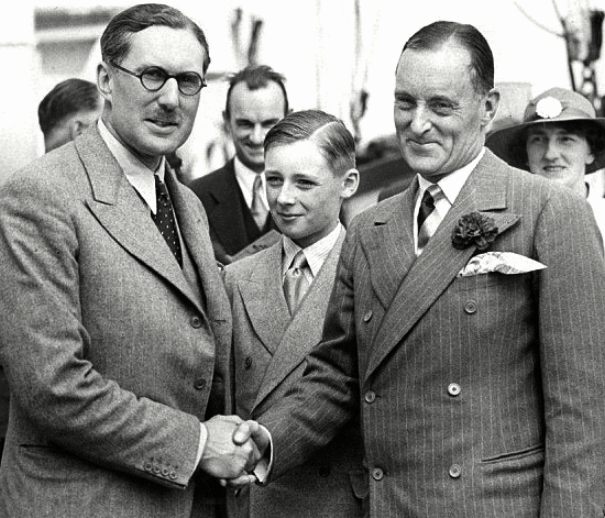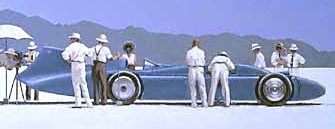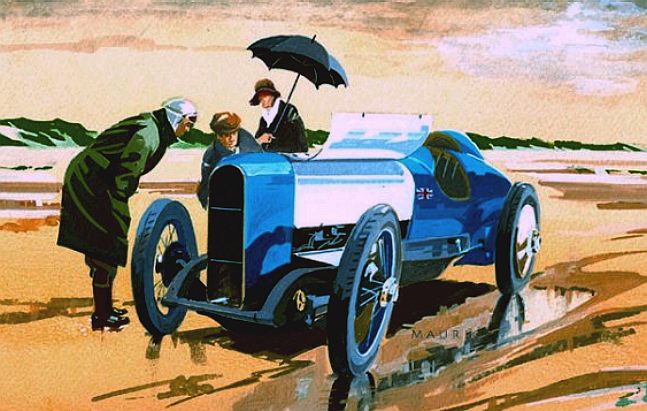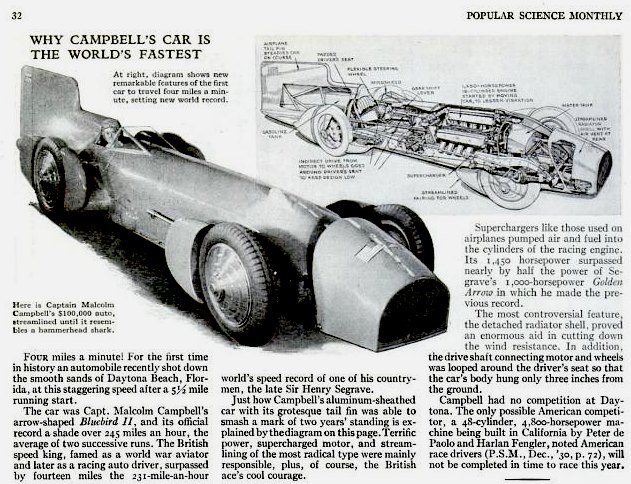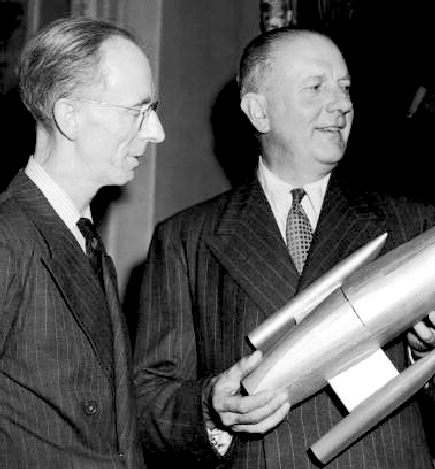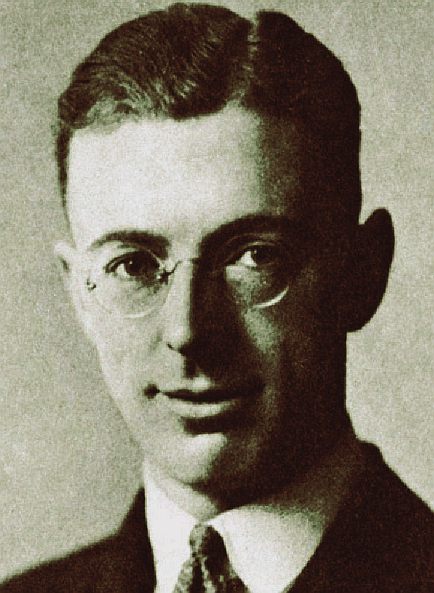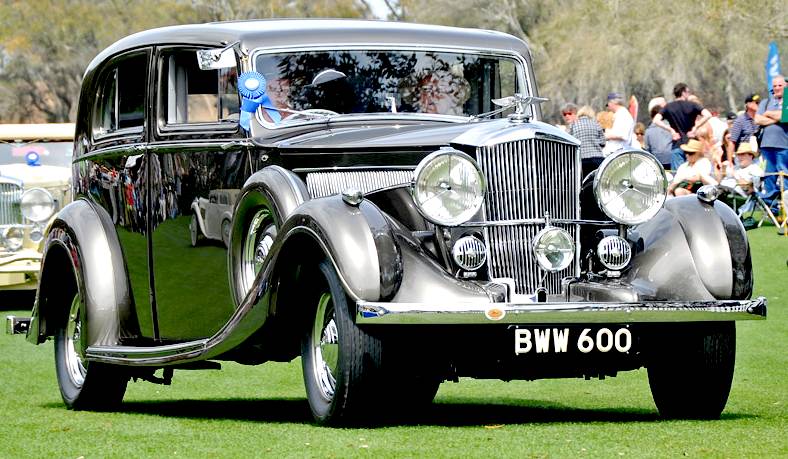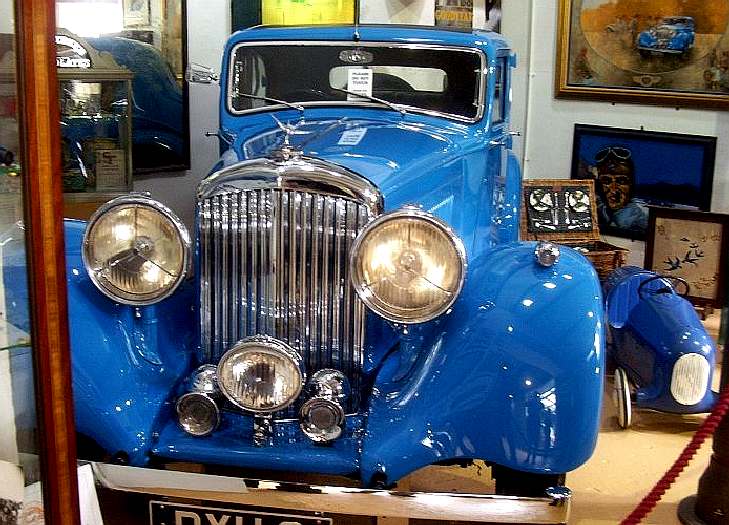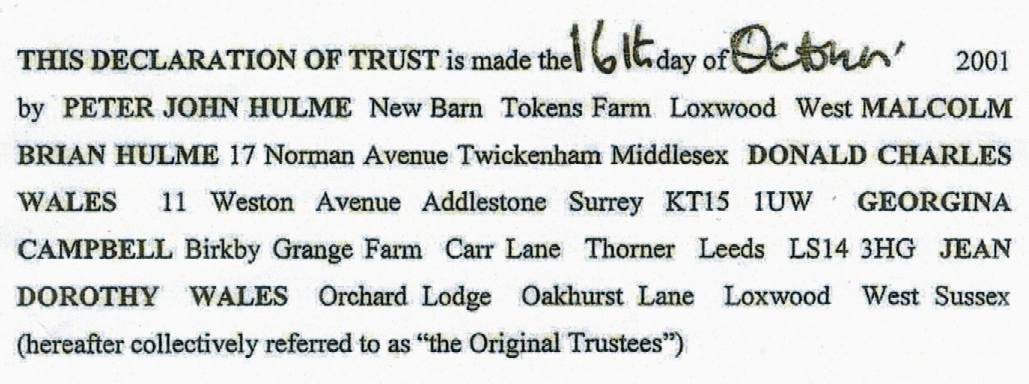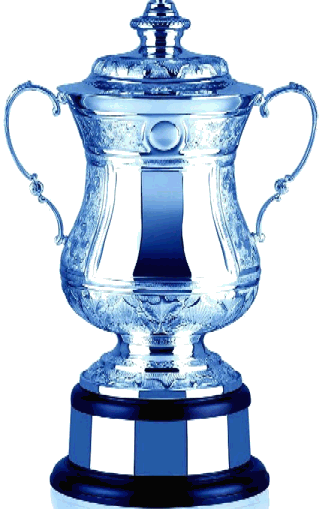|
MALCOLM CAMPBELL
|
|||
|
Sir Malcolm Campbell
Malcolm Campbell was a shareholder in Brooklands and very active in the running of the track, designing the Campbell road racing circuit within the confines of the site, which was used from its opening on 1st may 1937 to the outbreak of war. Throughout this period he was very active in all classes of racing at Brooklands driving a 1˝ litre Talbot, several Bugattis and the ex-Benoist straight eight supercharged G.P. Delage which was at the height of its fame in 1928 after numerous 1927 Grand Prix victories by its sister cars. In this car he dominated the 1928 200 Mile Race on 21st July, winning by 12 mins. 12 secs. at an average speed of 78.34 m.p.h.
For American auto racing, the Depression was a bleak period of little money and few races. But followers of the sport had something else to hold their attention - the continuing quest for the world land speed record. Some great names in American racing had held the record - Barney Oldfield, Ralph DePalma, Tommy Milton, even Henry Ford. But one man, an Englishman named Malcolm Campbell, seemed to capture the imagination of the entire world. It may have been the fact that he broke the record on nine occasions between 1924 and 1935, but more likely it was his later cars, all exotic and streamlined, and all named "Bluebird," that somehow provided both excitement and hope for the future in a world turned upside down by the economy and the long slow path toward another disastrous war.
Malcolm Campbell and the Railton Blue Bird with Napier engine: 25ft and 3.75 tons
Sir Malcolm Campbell broke the speed record another nine times in various "Bluebird" cars powered by both Napier and Rolls Royce engines. These records were as follows :
25th September 1924 (Pendine Sands) 146.16 mph 21st July 1925 (Pendine Sands) - 150.766mph 4th February 1927 (Pendine Sands) - 174.88mph, 12th February 1928 (Daytona Beach, Florida) - 206.95mph, 5th February 1931 (Daytona Beach) - 246.09mph, 24th February 1932 (Daytona Beach) - 253.96mph, 22nd February 1933 (Daytona Beach) - 272.46mph, 7th March 1935 (Daytona Beach) - 276.71, 3rd September 1935 (Bonneville Salt Flats, Utah) - 301.12mph.
Malcolm Campbell shakes the hand of a prominent sponsor
Sir Malcolm died after a long illness in 1949 and was succeeded by his son Donald who continued the record breaking tradition, breaking 400 m.p.h. in the turbine powered Bluebird CN7 now on loan in Lord Montagu’s National Motor Museum at Beaulieu.
The 27 foot long 4.75 ton Daytona Blue Bird with Rolls Royce engine
THE FUTURE
Any form of electric vehicle is better than petrol or diesel, but an electric vehicle that can refuel in a few minutes will obviously have much more customer appeal than an EV that has to wait 30 minutes or even hours to charge up.
Battery technology is improving daily. A car with the new generation of battery cartridge exchange built in and the ability to load its own cartridge, will encourage energy companies to build service forecourts.
The Blueplanet BE3 LSR Team would be pleased to advise any energy company interested in this technology and of course any vehicle manufacturer who might be considering whether or not to include a future proof system into their next generation of road cars.
Art: Bluebird paintings - Bonneville Salt Flats and Pendine Sands
REID RAILTON
Reid Antony Railton was the son of a Manchester
stockbroker. Reid was born in Chorley, Alderley Edge, Cheshire and was Christened on 13 August 1895 at the local parish church. He was educated at
Rugby School and Manchester University. He joined Leyland Motors in 1917 where he worked with J.G. Parry-Thomas on the Leyland Eight luxury car. He left in 1922 to set up the Arab Motor Company where he was chief designer. Only about twelve cars were built, of which two low-chassis cars survive. One is in the Isle of Man and the other one (Chassis number 6, engine number 10, registration UW 2) is now in Austria having been rebuilt and rebodied by David Barker in the early 1990s.
Popular Science magazine article on the Napier Lion engined monster car
REID'S CARS
Campbell-Napier-Railton Blue Bird
Reid Railton and John Cobb with Crusader model and Reid as a young man.
CAMPBELL-NAPIER-RAILTON BLUE BIRD
After Henry Segrave's
Golden Arrow, clearly a more powerful engine was required for Blue Bird, with a chassis and transmission to handle it. A supercharged Napier Lion VIID was used, with over three times the power of the previous Blue Bird and a large premium over Golden Arrow's
un-supercharged 900 hp (670 kW) Lion VIIA. This was not the first use of supercharging for Land Speed Record cars, but was the first combining supercharging with the large displacement aero engines that had previously been relied upon for their gross output. Golden Arrow's innovative vertical aerodynamic stabilising fin was also used, a first for Campbell.
A Hudson-Railton saloon (1937) and Sir Malcolm's Bentley at a museum in Cumbria
CAMPBELL-RAILTON BLUE BIRD (ROLLS ROYCE)
His previous
Campbell-Napier-Railton Blue Bird of 1931 was rebuilt significantly. The overall layout and the simple twin deep chassis rails remained, but little else. The bodywork remained similar, with the narrow body, the tombstone radiator grille and the semi-spatted wheels, but the mechanics were new. Most significantly, a larger, heavier and considerably more powerful Rolls-Royce R V12 engine replaced the old Napier Lion, again with supercharger. This required two prominent "knuckles" atop the bodywork, to cover the V12 engine's camboxes.
THE MALCOLM CAMPBELL HERITAGE TRUST (MCHT)
You can see from the scans of what appears to be a 'Declaration of Trust' dated the 16th of October 2001, that the original Trustees of the MCHT were:
1. Peter John Hulme, New Barn, Tokens Farm, Loxwood, West Sussex. 2. Malcolm Brian Hulme, 17 Norman Avenue, Twickenham, Middlesex. 3. Donald Charles Wales, 11 Weston Avenue, Addlestone, Surrey, KT15 1UW. 4. Georgina Campbell, Birkby Grange Farm, Carr Lane, Thorner, Leeds, LS14 3HG. 5. Jean Dorothy Wales, Orchard Lodge, Oakhurst Lane, Loxwood, West Sussex.
For more information of this Trust, click on the document extract above.
LINKS & REFERENCE
Campbell-Napier-Railton_Blue_Bird http://en.wikipedia.org/wiki/Reid_Railton http://en.wikipedia.org/wiki/Campbell-Napier-Railton_Blue_Bird http://en.wikipedia.org/wiki/Campbell-Railton_Blue_Bird Blue Bird 1933". Bluebird team racing. "1933 Blue Bird". Brooklands photo archive. "1933 Blue Bird from the rear". Brooklands photo archive. "Blue Bird, 1933". many period photos "Running at Brooklands". Brooklands photo archive. "On the banking at Brooklands". Brooklands photo archive. "Engine and chassis in the workshops, bodywork removed. Note the airbrake actuating cylinder.". Brooklands photo archive. "Bluebird 1935". Bluebird team racing. "Cockpit, showing the double wheels and also the airbrake flaps". Brooklands photo archive. "Blue Bird, 1935". Racing Campbells. "Blue Bird at Daytona, 1935". many period photos "Bluebird at Bonneville, 1935". many period photos
Vehicle design inspired by Reid Railton and Sir Malcolm Campbell's spectacular record runs at Daytona Beach, the BE3 is probably the world's fastest electric car: 350mph + using energy from nature featuring patent built in battery cartridge exchange refueling. The name Bluebird™ and flying blue bird legend are registered trademarks concerning battery cartridge exchange recharging.
The Bluebird World Cup Trophy challenge
|
|||
|
This
website is copyright © 1991- 2014 Max Energy Ltd. All rights
reserved. The bird logo |
